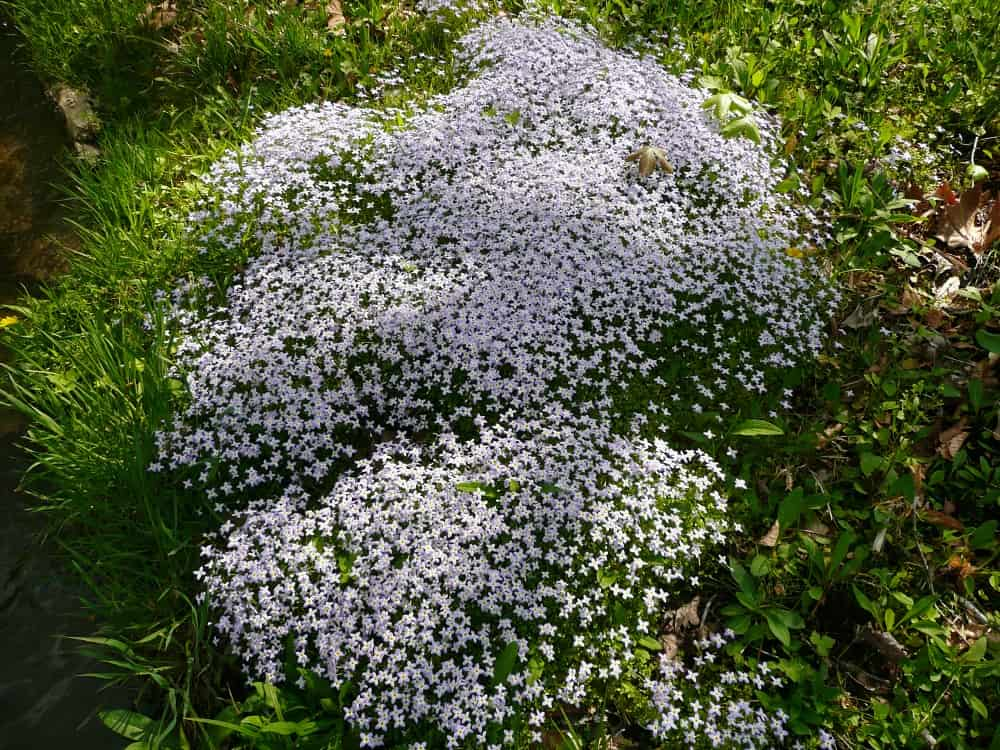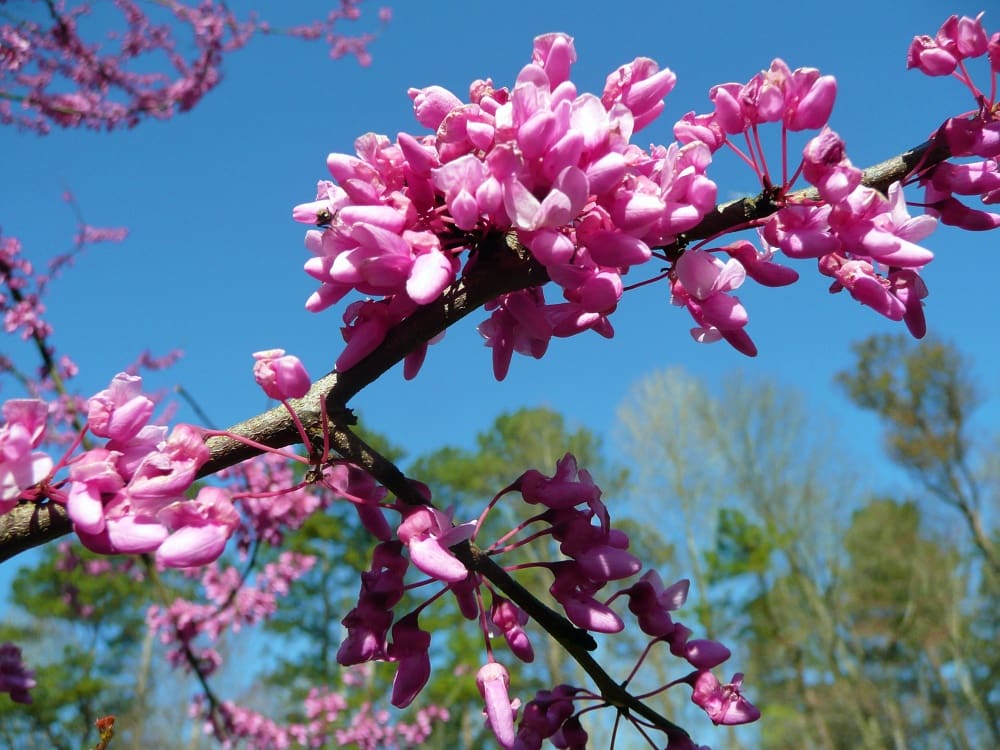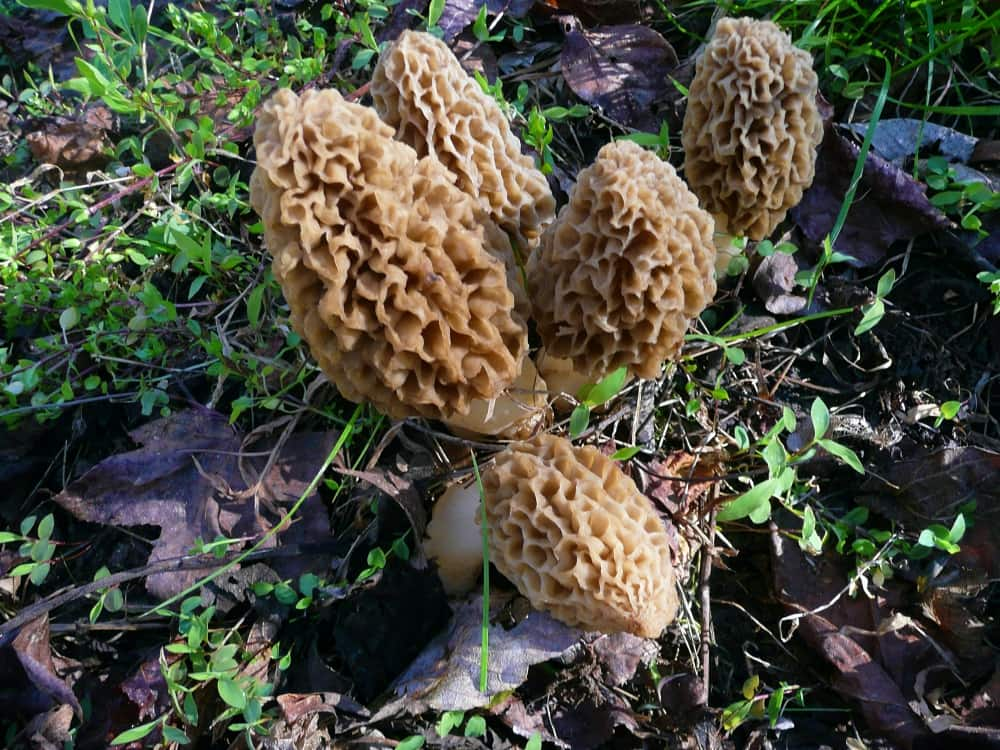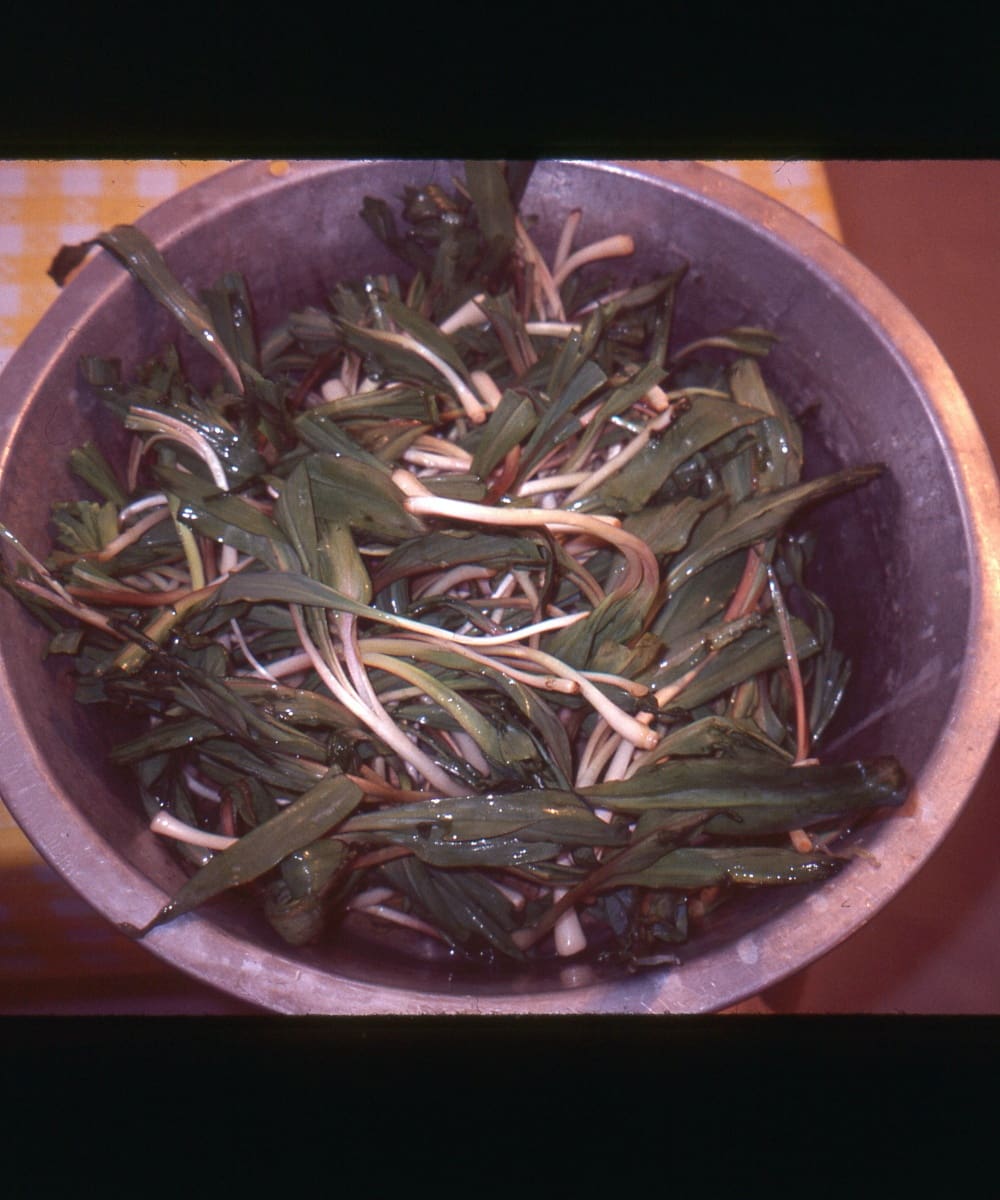MARCH NEWSLETTER

Bluets
I’m always tickled when the month of March rolls around. Along with uncertain weather it brings with it all sorts of good things—rising trout, gobbling turkeys, blooming wildflowers, spring vegetables in the garden, poke salad, dandelion greens, and more. It puts added friskiness and maybe a tad more riskiness in youngsters while putting a bit more pep in the steps of oldsters. It also signals the beginning of the end to winter, although based on a lifetime’s experience I think it’s a pretty sure bet that some of the month’s vagaries and less appealing side–bitter breezes, killing frosts, chilling rains, and the like–are yet to come before spring truly arrives. Nonetheless, crocus blooms here have come and gone, daffodils are already fading, red maples are fully budded out, and bluebirds are checking out a backyard box with a far more serious mien than is the case in their periodic stop-and-look ventures during the winter. It’s also time to get out my hummingbird feeders, although the first ones don’t usually show up here until around April 20.
Old Will Shakespeare, with whom I struggled mightily in high school and to a lesser degree in college, knew what he was talking about when he suggested it was wise to beware of the Ides of March. It’s a month that mixes magic with occasional madness. My beloved Grandpa Joe used to call it the month of hope and renewal. “In many ways it’s really a pretty miserable month,” he would opine, “because hunting season is closed and gone for a long while (there were no wild turkeys in those days in the Smokies of my youth), it’s far too cold to fish for trout (that was in the days when everyone waded wet), and more often than not the weather is ornery. Still, March means that April and May ain’t far away, and just thinking of them lifts my spirits. First thing you know we’ll have a mess of black-seeded Simpson lettuce from the garden, and by the end of the month anyone with a decent amount of gumption can gather a bait of dandelion greens.”
Warming to his subject, Grandpa Joe would then reminisce about memorable experiences from his past associated with this general time of year—a late March snowstorm, “yarbing” (gathering herbs for medicinal use), making sweet syrup from maples (we think of that as something confined to more northern climates, but “tree sweetening” was once fairly common in the Smokies—there’s even a place in the Park just over the main ridgeline of the Appalachians from the place of my birth known as The Sugarlands), and the like.
One of the things about March which fascinated me then as much as it does now was planning connected with planting gardens. Grandpa firmly believed in planting by the signs, and to that end he studied the Farmer’s Almanac and considered it absolute gospel. If the signs weren’t right seed potatoes would not go into the ground; and if the Almanac said it was a time for root crops to go the ground, then things like cabbage and broccoli would just have to wait their turn. I must confess that I think Grandpa was onto something. I don’t always plant by the signs, but his resounding and consistent success was such it pretty well shredded any arguments about planting when the spirit happened to move you as opposed to following the dictates of the signs.

A long-spurred longbeard like this one always evokes a smile.
Another fond memory from those long ago days focused on Grandpa’s discussion of wild turkeys. I never saw one of the grand birds until long after he was gone (he died when I was twenty-five years of age), but I had read about them in the writings of one of my boyhood literary heroes, Charlie Elliott, and my all-time favorite sporting scribe Robert Ruark, had one turkey-hunting tale in his incomparable book, The Old Man and the Boy. Grandpa talked about the special sound gobblers made in the mating season, and according to him, “once you hear it you realize a bird can shake the ground and stir the soul.” Was he ever right on this score, as was the case on so many other things!

Redbud
It won’t be long until the rites of the spring woods once more arrive, and already thoughts of being in the woods at dawn move me to the depths of my soul. But then, so do simpler pleasures connected with early spring. To walk through woodlands where service trees add a splash of white to a grim, grey landscape, is to tread through wonder. The same holds true for glimpses of the first flowering bluets, bloodroots peeking through leaf mold, the shiny green of emerging Mayapple leaves, and the first pink of swelling redbud blooms.

If I’m lucky, a sidelight of turkey hunting
will be finding morel mushrooms (“merkles”)
Then there’s the wonder of morels (no wonder Appalachian folks called the tasty mushrooms “merkles,” a colloquial way of saying “miracles”). Early spring uplifts one’s spirits in so many ways, and as I grow older I enjoy the profusion of wildflowers, a parade of color which becomes more beautiful as March gives way to April, and April to May, even more than I used to. Or maybe it would be more accurate to say that in the turkey woods or just wandering, I pause and ponder a bit more than used to be the case. Maybe some of that’s lack of fitness and shortness of breath, but I’d also like to think that passing years have endowed me with a bit more in the way of an ability to appreciate the natural world.

The arrival of March, for all that the wild turkey holds a corner of my soul, also holds great meaning for me as a lifelong fly fisherman. A decade and a half ago I poured my heart and soul into a book on pursuing the sport in my native heath, the Great Smokies, and if you love the long rod and whistling line and haven’t yet acquired it, I would humbly direct your attention to Fly Fishing in the Great Smoky Mountains National Park: An Insider’s Guide to a Pursuit of Passion. I considered it the most important book I’ve ever done at the time, although since that point I’d probably give my recent A Smoky Mountain Boyhood: Memories, Musings, and More pride of place. Of course I obviously pretty much the last person fit to judge the true merits of either work.
When I was a youngster the trout season always opened the first Saturday in April, a sharp contrast with the situation now, where some streams (all of those in the Great Smoky Mountains National Park) are open throughout the year. That meant building anticipation as March marched along, occasional walks along streams to look for insect life and see if any fish were rising, and maybe a sneak preview fishing for knottyheads and bream in the nearby Tuckaseigee River. Today, as a longtime friend and fishing buddy Marty Maxwell puts it, I “ain’t as catty as used to be the case.” He made that comment after laughing at me staggering all over the creek as I tried to maintain my balance, only to have him offer a remarkably similar encore a half hour later.

A bowl of cooked ramps
Another aspect of March which I have always cherished is associated with the old mountain custom of taking “tonics” in this month. In my youth these took varied forms, from sulphur and molasses to thin the blood to infusions of sassafras tea for one’s general health. Spring greens such as poke salad did double duty as a purgative, and there were always some who thought even the most nauseous of nostrums could be rendered palatable by being taken with a good slug of peartin’ juice (for the uninformed, that’s moonshine). Not too long prior to his arrest and subsequent suicide, I discussed such matters with the notorious Popcorn Sutton. He was a genuine mountain character and lifelong producer, purveyor, and consumer of corn squeezin’s. Popcorn’s studied opinion was that “a body needs some properly made likker, along with a mess of trout and bait of ramps and branch lettuce,” to get into spring in proper fashion.
I’m not at all sure Popcorn’s spring tonic was the best, although I will acknowledge that I have a jar of his liquid magic that I acquired a year or so before his death set aside for a truly special occasion. Perhaps more to the point, March is a month for some fine late winter eating. Maybe your feasting takes the form of savory venison chili simmering in the crockpot, and the marriage of flavors blending as smells emanating from the kitchen threaten to make one’s salivary glands run amok is might nigh irresistible.
If you are blessed (as I am this year, having taken six fine does and stored them in the freezer after a great deal of help in processing from my good hunting buddy, Darrin Dawkins, and his son, Josh) to have plenty of venison, you’ll have meat right on through the summer. However, on other fronts March is a time for some freezer cleaning out, a month for hearty soups, and a time for the simple pleasures of things such as a fine pone of cornbread or a big pot of pinto beans cooked with ham hock. This time of the year I have soup at least once a week—maybe a hearty potato soup, venison vegetable soup, split pea and ham soup, and more. I can eat soup regularly in chilly weather and be happy as a hog wallowing in mud hole on a hot July day. It’s just the ticket for those spells when March turns blustery and chill winds blow. Right now we’ve got a high wind advisory with gusts to 45 m. p. h. predicted, so I reckon it’s time to get the soup pot on the boil. While I do so I’ll enjoy a slice or two of the venison summer sausage processed back in the fall—it goes mighty well with what old-timers used to call rat cheese and some soda crackers, maybe with a splash of mustard for a bit of bite—and this simple hillbilly will be dining like a king.
JIM’S DOIN’S
Much of my time in the last month has been devoted to dealing with a local auctioneer who offered a small selection of my lifetime accumulation of “stuff” along with my own efforts at selling a goodly portion of the turkey calls I’ve accumulated over the decades. The auction went well and I’ll probably be involved in a sequel 12 to 18 months down the road. Meanwhile, there are a lot of turkey calls still available, and any reader who is interested can e-mail me (jimcasada@comporium.net) and I’ll send you a completely up-to-date list of what’s available.
On the book front there’s been final approval of the cover material for Fishing for Chickens: A Smokies Food Memoir, and just a couple of days ago I sent in the dust jacket bio and a mug shot for Lords of the Veldt and Vlei: Africa’s Pioneer Hunters. I’ll also have the concluding chapter in an upcoming collection of writings on hunting that is to be published by the University of Georgia Press. Recently published articles include “Corn: A Feast for All Seasons,” Columbia Metropolitan, March, 2022, pp. 40-43; “William Cornwallis Harris: The Man Who Popularized Hunting in Africa,” Sporting Classics, Mar./Apr., 2022, pp. 49-52; “Trout Magic in Words: The Anatomy of a Fly Fisherman,” Sporting Classics, Mar./Apr., 2022, pp. 147-50; “There Are Strange Things Done in the Springtime Sun,” Sporting Classics, Mar./Apr., 2022, pp. 72-79; “Gifts from the Gardening Gods,” Smoky Mountain Living, Apr./May, 2022, pp. 14-17; and “Dave Harbour: Called to Adventure,” Sporting Classics, 2022 Adventure issue, pp. 139-42.
RECIPES
As usual, we’ll wrap up the newsletter with a selection of recipes. Here are some offerings I hope will tempt you, maybe give you reason to wander off the culinary main track a bit, open up new eating vistas, or resurrect fond food memories.
POKE SALLET
Poke sprouts, which appear this time of year after a fall and winter hiatus, need to be picked when they are six inches or less in height. Finding them is easy enough, since the dead bushes from the previous year leave all the evidence you need. Also, pokeweed is incredibly hardy, coming back year after year, and it grows widely and prolifically. Once you have the tender shoots, thanks to the fact they actually carry too much Vitamin A, you need to clean the sprouts and bring them to a rolling boil for 10 minutes or so. Then drain, cover with cold water, and repeat the process. Drain yet again and the third time you are in the eatin’ mode. If you don’t mind the cholesterol, add a slice or two of streaked meat at this juncture, or maybe some bacon drippings. Serve with sliced boiled eggs, bacon bits, or crumbled fatback which has been fried to a crisp atop the “sallet.” Talk about fine!
In just a few days I’ll be greeting the first dawn of April somewhere in the turkey woods. If Dame Fortune smiles (and I’m not too optimistic since our wild turkey population is way down), I’ll be toting a fine tom home with me. Wild turkey is delicious in many ways, but here’s a bit of an offbeat way to enjoy the grand bird.
TURKEY AND WILD RICE SOUP
6 tablespoons margarine or butter
½ cup chopped onion
1 cup chopped celery
½ cup chopped carrots
½ cup sliced fresh mushrooms
6 tablespoons all-purpose flour
Salt and pepper to taste
2 (10-ounce) cans chicken broth
4 cups milk
2 cups cooked wild rice
2 cups cubed cooked turkey (you can substitute meat pulled from the carcass of a baked or roasted turkey)
Melt the margarine in a large pan and sauté the onion, celery, carrots, and mushrooms until tender-crisp. Stir in the flour, salt, and pepper and mix well. Add the chicken broth and milk and cook, stirring, until thickened. Add the wild rice and turkey. Adjust seasonings and simmer until heated through.
BARLEY VENISON SOUP
I always try to make sure I have plenty of ground venison in the freezer, and one reason is that it can be prepared in so many ways. Here’s one of my favorites, and it’s a hearty offering that will flat-out stick to your ribs.
1 cup fine barley, rinsed and drained
1 small onion
4 cups beef broth
3 cups frozen mixed vegetables, thawed
1 can (46-ounce) tomato juice
3 or 4 cups leftover venison stew or browned venison burger
1 teaspoon sugar
Salt and pepper to taste
Bring broth to a boil and add washed barley, chopped onion and frozen vegetables. Cook on low about 40 minutes until barley and veggies are done. Add tomato juice, venison, and seasonings. Simmer until piping hot.
Great served with cornbread.
BLACK BEAN SOUP
Here’s another soup that features venison, this time in the form of venison kielbasa sausage to “back up” the beans and give you plenty of protein along with tempting taste blends.
2 cups black beans, cleaned, rinsed and soaked
6 cups cold water
2 cups chicken broth
1 medium onion, chopped
1 garlic clove, minced
2 tablespoons margarine
2 bay leaves
2 tablespoons parsley
1 ham hock
1-2 cups venison kielbasa or smoked venison sausage, finely chopped
Salt and pepper to taste
Soak beans, then drain. Fill Dutch oven with ham hock, beans, water and broth. Cook on low until beans are tender. Sauté garlic, onion, and parsley in margarine and add to soup along with other ingredients. Continue cooking over low heat until beans are soft (about three hours). Add small amount of water if the soup becomes too thick. Remove bay leaves and hock, chopping ham from the latter into small pieces. Garnish with shredded cheddar cheese, sour cream, and chopped onion.